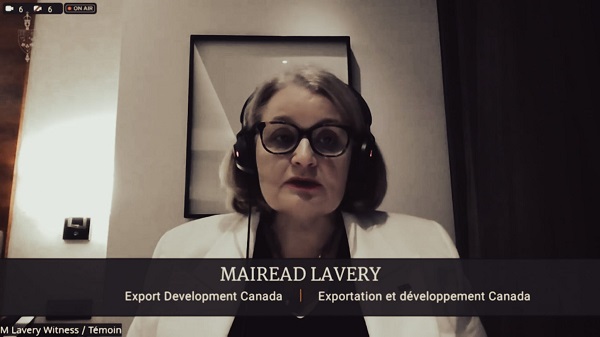Business
Auditor General: $3.5 Billion in CEBA Loans Went to Ineligible Businesses, Recovery Efforts Lacking.

A $3.5 Billion Disaster Exposes Government Negligence, Corporate Greed, and a Total Lack of Accountability
Welcome to the latest edition of “What the Government Doesn’t Want You to Know.” Tonight, we’re talking about Canada’s Canada Emergency Business Account (CEBA) program—a pandemic-era scheme that was supposed to help struggling businesses. Instead, it’s a case study in waste, corruption, and outright negligence.
Here’s what we learned during a bombshell hearing of the Standing Committee on Public Accounts (PACP) Wednesday: $3.5 billion in taxpayer money was handed out to ineligible businesses, 92% of the contracts went to one company, Accenture, without any competitive bidding, and there’s virtually no accountability for any of it.
Let’s break it down.
$3.5 Billion Vanishes, and No One Cares
Here’s what we learned from the Auditor General: The Canada Emergency Business Account program—$49 billion handed out to almost a million small businesses during the pandemic—was a mixed bag. On the one hand, they moved fast. Great. But on the other hand, it was a fiscal train wreck in terms of accountability. And let’s be clear: “accountability” is supposed to be their job.
Now, here’s the kicker. We find out that $3.5 billion—yes, billion with a “B”—went to businesses that didn’t even qualify. That’s our money, taxpayer money, handed over to ineligible recipients. What’s their excuse? Well, they were in a rush, they say. Of course, they were. Crises always become the justification for sloppy governance and waste.
Then there’s Export Development Canada—the folks running this show. They outsourced 92% of their contracts for this program to one company, Accenture. No competitive bidding, no oversight, just one big fat sweetheart deal. And get this: Accenture essentially got to write its own terms. They gave themselves the keys to the vault. They even built systems that made EDC dependent on them until 2028. That’s right—they locked themselves in for years, turning a pandemic emergency into a lucrative, long-term cash cow.
What about the Department of Finance and Global Affairs Canada? Were they stepping in, asking tough questions, setting clear limits? Nope. They were nowhere to be found. Total accountability vacuum. And by the way, administrative costs for this program? Over $850 million. Think about that. You can’t make this stuff up.
And when the Auditor General says, “Hey, maybe you should track down that $3.5 billion and recover it,” EDC just shrugs. They “partially agree.” Partially? Imagine if you told the CRA you “partially agree” with paying your taxes. See how that goes.
Here’s the reality: This is what happens when a government prioritizes speed over basic responsibility. They let the fox guard the henhouse, and now they want us to move on and forget about it. But we shouldn’t. This isn’t just bad management—it’s a betrayal of public trust. It’s our money, and they treated it like Monopoly cash.
So, who’s going to be held accountable? Who’s going to pay the price for this colossal mess? The answer, as usual, is probably no one.
Accenture’s Sweetheart Deal
Here’s the part that should really make your blood boil: $342 million worth of CEBA contracts went to consulting giant Accenture. No competitive bidding. No oversight. Nothing. Just a blank check from EDC with your money.
And it gets worse. Accenture didn’t just get the money—they subcontracted work to themselves. That’s right, they paid themselves with your money. And here’s the kicker: EDC is locked into contracts with Accenture until 2028. So, for the next four years, taxpayers will keep paying this consulting giant, all because EDC couldn’t be bothered to shop around or demand accountability.
Lavery’s excuse? “We needed speed and expertise during the pandemic.” Speed doesn’t justify corruption. It doesn’t justify giving one private company complete control over a multi-billion-dollar program. This isn’t just incompetence; it’s a rigged system designed to enrich consultants at the expense of taxpayers.
$853 Million in Administrative Costs
Let’s talk about efficiency—or the lack thereof. The CEBA program cost $853 million to administer. That’s $300 per loan, according to EDC. Lavery called that “reasonable.” Reasonable? For what? Businesses reported that the call center EDC spent $27 million on barely worked. Think about that: $27 million for a call center where you can’t even get someone to pick up the phone.
Conservative MP Brad Vis summed it up perfectly: “For $27 million, you’d expect a call center that actually answers calls.” But instead, Canadians got more of the same—an expensive, inefficient system that’s great for consultants and terrible for everyone else.
Conservatives Demand Accountability for CEBA Mismanagement: ‘A Blank Check for Consultants’
The Conservatives didn’t hold back in yesterday’s hearing, demanding accountability for what they called a blatant misuse of taxpayer dollars. Conservative MP Brad Vis led the charge, grilling EDC President Mairead Lavery on the $3.5 billion in loans that went to ineligible businesses. He didn’t mince words, calling out the government’s failure to put basic safeguards in place. “How did this happen, and what’s being done to recover this money?” Vis asked repeatedly, only to be met with vague assurances that EDC was “working with Finance Canada” on the issue. Translation: Nothing is actually happening.
MP Kelly McCauley took aim at the $342 million handed to Accenture without a single competitive bid. “How can you justify giving 92% of CEBA contracts to one company without opening it up to competition?” he asked, pointing out that Accenture even subcontracted work to itself, effectively turning the program into a taxpayer-funded cash cow for consultants. McCauley wasn’t buying Lavery’s excuses about pandemic urgency, pointing out that this kind of procurement failure wasn’t just a one-time mistake—it was a systemic problem.
John Nater, another Conservative MP, zeroed in on the long-term fallout. He expressed outrage that EDC is locked into a contract with Accenture until 2028, ensuring that taxpayers will continue funding this flawed system for years to come. Nater demanded to know why no one at EDC or in government thought it necessary to implement oversight mechanisms once the initial rollout phase had passed. “This isn’t just about speed. It’s about accountability. Where was the oversight? Where was the plan to safeguard public money?” Nater asked.
The Conservatives’ message was clear: this wasn’t just a case of pandemic-related haste—it was a failure of leadership, oversight, and governance. They demanded consequences for those responsible and reforms to prevent similar disasters in the future. As McCauley aptly put it, “This wasn’t an emergency response. It was a blank check for consultants, and taxpayers are the ones paying the price.”
Liberals Spin CEBA Disaster as a Success: ‘Sweeping It Under the Rug
The Liberal response to this mess was as predictable as it was infuriating: deny, deflect, and downplay. Instead of addressing the core issues—like the $3.5 billion in loans to ineligible businesses or the sweetheart contracts handed to Accenture—Liberal MPs spent their time patting themselves on the back for the program’s “success” and running interference for Export Development Canada (EDC).
Take Francis Drouin, for example. He spent his time emphasizing how quickly the CEBA program got money into the hands of struggling businesses. Sure, the program distributed $49.1 billion, but at what cost? When confronted with the Auditor General’s findings about fraud, waste, and mismanagement, Drouin brushed past the hard questions and pivoted back to the pandemic. It was a textbook move: ignore the billions lost and focus on how hard the government worked. Typical.
Then there was Valerie Bradford, who followed the same script. Instead of demanding answers about why 92% of contracts went to one consulting firm without competitive bidding, she lobbed softball questions that gave EDC President Mairead Lavery the chance to repeat her excuses about “urgency” and “unprecedented circumstances.” Bradford didn’t challenge the inflated administrative costs, the useless $27 million call center, or the lack of oversight. Instead, she chose to frame the discussion as if this was all just the price of doing business in a crisis.
This wasn’t accountability. This was damage control. The Liberals weren’t there to ask hard questions—they were there to protect their narrative. To them, it doesn’t matter that taxpayers got fleeced. It doesn’t matter that consultants got rich while businesses were left waiting for answers. All that matters is spinning this disaster into a success story, no matter how far from the truth that is.
What’s most galling is the arrogance. The Liberals seem to think Canadians should be grateful for a program that wasted billions, enriched corporations, and locked taxpayers into a disastrous contract until 2028. It’s as if they expect a thank-you card for their incompetence.
Here’s the reality: the Liberal response wasn’t about addressing the scandal. It was about sweeping it under the rug. And unless Canadians demand better, this is the kind of governance they’ll keep getting: one where failure is rebranded as success, and no one ever takes responsibility for the consequences.
Final Thoughts
So, what did we learn from this so-called committee meeting? We learned that billions of taxpayer dollars can be wasted, handed out to ineligible businesses, and funneled into the pockets of consultants without anyone in government blinking an eye. We learned that accountability is a foreign concept in Ottawa, where “working on it” is the go-to excuse for incompetence and outright negligence.
Export Development Canada failed. The Department of Finance failed. The Liberals in charge failed. But here’s the kicker—no one will pay for it. Not the bureaucrats who bungled the program, not the consultants who profited from it, and certainly not the politicians who allowed this circus to happen.
Instead, we got a performance. A parade of excuses, vague promises, and shameless spin. The Conservatives tried to hold the government’s feet to the fire, but the Liberals spent their time running cover for the mess they created. And the Bloc and NDP, while occasionally landing a punch, ultimately let the bureaucrats wiggle off the hook. This wasn’t accountability; it was theater.
The CEBA program wasn’t just a failure—it was a lesson in how the system really works. When there’s no oversight, no consequences, and no urgency to fix anything, corruption and incompetence become the norm. Consultants get rich, bureaucrats get a pass, and taxpayers get the bill.
And the people running this committee? They’re part of the problem. They don’t want to fix the system because the system works perfectly for them. It rewards their friends, protects their power, and keeps them unaccountable. This wasn’t a hearing; it was a farce. And unless Canadians demand real change, this won’t be the last time their government lets them down.
So, ask yourself this: How much more are you willing to let them get away with? Because as long as you stay quiet, they’ll keep doing exactly what they did here—wasting your money, spinning their failures, and walking away without a scratch.
Please consider subscribing to The Opposition with Dan Knight .
For the full experience, upgrade your subscription.
Business
Feds pull the plug on small business grants to Minnesota after massive fraud reports

The Small Business Administration is moving to freeze grant money flowing into Minnesota after explosive allegations of large-scale fraud tied to state oversight failures, with SBA Administrator Kelly Loeffler signaling an immediate crackdown following recent independent reporting.
In a series of comments shared publicly by conservative commentator Benny Johnson, Loeffler said the agency is “cutting off and clawing back” SBA grants to the state while investigators dig deeper into what she described as a rapidly expanding fraud network.
Johnson wrote that Loeffler told him she was “disgusted and sickened” after reviewing footage from YouTuber Nick Shirley, whose on-the-ground reporting in Minnesota highlighted what he said were sham daycare and learning centers collecting millions in public funds despite showing little or no sign of legitimate operations.
According to Johnson, Loeffler blamed the situation on Democrat Gov. Tim Walz, accusing his administration of refusing to enforce basic rules governing small businesses and allowing fraud to flourish unchecked.
Johnson said Loeffler told him SBA investigators were able to identify roughly half a billion dollars in suspected fraud within days of focusing on Minnesota, calling the operation an “industrial-scale crime ring” that ripped off American taxpayers.
“Pending further review, SBA is freezing all grant funding to the state in order to stop the rampant waste of taxpayer dollars and uncover the full depth of fraud,” Loeffler said, according to Johnson’s account, adding that the total scope of the scheme remains unknown and could reach into the billions.
The controversy gained national traction after Shirley posted video of himself visiting multiple facilities, including a South Minneapolis site known as the Quality Learning Center, which he reported was approved for federal aid for up to 99 children but appeared inactive during normal business hours.
The center’s sign, Shirley noted, even misspelled the word “learning” as “learing.”
In the footage, a woman inside the building is heard shouting “Don’t open up,” falsely claiming Shirley and his colleague were Immigration and Customs Enforcement agents.
After the video circulated, Rep. Tom Emmer, a Republican, publicly demanded answers from Walz, questioning how such facilities were approved for millions in taxpayer funding.
Shirley’s reporting followed earlier investigations, including a November report by City Journal alleging that members of Minnesota’s Somali community had sent millions of dollars in stolen taxpayer funds overseas, with some of that money reportedly ending up in the hands of Al-Shabaab, a U.S.-designated terrorist organization.
While Walz’s administration has insisted it takes fraud seriously, the SBA’s decision to halt grant funding marks one of the most aggressive federal responses yet, underscoring how rapidly a local scandal has escalated into a national reckoning over oversight, enforcement, and accountability in Minnesota.
Business
Stripped and shipped: Patel pushes denaturalization, deportation in Minnesota fraud

FBI Director Kash Patel issued a blunt warning over the weekend as federal investigators continue unraveling a sprawling fraud operation centered in Minnesota, saying the hundreds of millions already uncovered represent “just the tip of a very large iceberg.”
In a lengthy statement posted to social media, Patel said the Federal Bureau of Investigation had quietly surged agents and investigative resources into the state well before the scandal gained traction online. That effort, he said, led to the takedown of an estimated $250 million fraud scheme that stole federal food aid intended for vulnerable children during the COVID pandemic.
According to Patel, the investigation exposed a network of sham vendors, shell companies, and large-scale money laundering operations tied to the Feeding Our Future case. Defendants named by the FBI include Abdiwahab Ahmed Mohamud, Ahmed Ali, Hussein Farah, Abdullahe Nur Jesow, Asha Farhan Hassan, Ousman Camara, and Abdirashid Bixi Dool, each charged with offenses ranging from wire fraud to conspiracy and money laundering.
Patel also said Abdimajid Mohamed Nur and others were charged in a separate attempt to bribe a juror with $120,000 in cash. He noted that several related cases have already resulted in guilty pleas, prison sentences of up to 10 years, and nearly $48 million in restitution orders.
Despite those outcomes, Patel warned the case is far from finished.
“The FBI believes this is just the tip of a very large iceberg,” he said, adding that investigators will continue following the money and that the probe remains ongoing. Patel further confirmed that many of those convicted are being referred to immigration authorities for possible denaturalization and deportation proceedings where legally applicable.
The renewed focus follows a viral video circulated by independent journalist Nick Shirley, which appeared to show multiple childcare and learning centers operating as empty or nonfunctional storefronts. The footage sparked immediate backlash from Republicans, including Vice President JD Vance.
House Majority Whip Tom Emmer accused Minnesota Gov. Tim Walz of sitting idle while massive sums were stolen from taxpayers. Walz addressed the allegations during a November press conference, before the full scope of the fraud became public, saying the scandal “undermines trust in government” and threatens programs meant to help vulnerable residents.
“If you’re committing fraud, no matter where you come from or what you believe, you are going to go to jail,” Walz said at the time.
Authorities say the alleged schemes date back to at least 2015, beginning with overbilling Minnesota’s Child Care Assistance Program and later expanding into Medicaid-funded disability and housing programs. One such housing initiative, aimed at helping seniors and disabled residents secure stable housing, was shut down earlier this year after officials cited what they described as large-scale fraud.
The fallout has already reached the federal level. Last month, President Trump announced the suspension of Temporary Protected Status for Somali nationals, arguing that Minnesota had become a hub for organized welfare fraud and money laundering activity.
-

 Digital ID2 days ago
Digital ID2 days agoCanadian government launches trial version of digital ID for certain licenses, permits
-

 Agriculture2 days ago
Agriculture2 days agoEnd Supply Management—For the Sake of Canadian Consumers
-

 Alberta2 days ago
Alberta2 days agoAlberta Next Panel calls to reform how Canada works
-

 International1 day ago
International1 day agoGeorgia county admits illegally certifying 315k ballots in 2020 presidential election
-

 Business1 day ago
Business1 day agoThe “Disruptor-in-Chief” places Canada in the crosshairs
-

 Artificial Intelligence2 days ago
Artificial Intelligence2 days agoUK Police Pilot AI System to Track “Suspicious” Driver Journeys
-

 Energy1 day ago
Energy1 day ago‘The electric story is over’
-

 International2 days ago
International2 days agoWorld-leading biochemist debunks evolutionary theory








